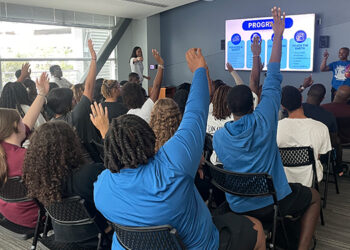Just as cell phone policies in campus rec have been changing over the years, so has workout attire. It’s important to revisit these policies to ensure they are still relevant, to make sure patrons are aware and to adjust any necessary changes that need to be made.
For example, Indiana State University campus rec is currently reevaluating their dress code because it has been in place for over 10 years and has outdated signage. “We will be transitioning away from using photos of actual people and will consist of animated examples that our university marketing department is designing,” said Nicholas Horton, the assistant director of operations at Indiana State.
In the future, Horton elaborated the updated policy signage will be added to the campus rec website, sent out in social media reminders throughout the year, as well as placed at the welcome desk and in high traffic areas around the building.
Enforcing dress codes can be an uncomfortable challenge for staff. This is why Indiana State practices scenario training on how to have conversations with patrons and explain the “why” of the policy. “Also, if individuals don’t have anything to change into, I have added some extra shirts at our welcome desk they can check out, so they can still complete their workout,” explained Horton.
The “why” of having a dress code in campus rec centers is generally universal. Cheri Jenkins, the associate director of operations in campus recreation services at the University of Utah, explained the importance of this policy is mainly due to hygiene. “For purposes of hygiene, safety and protection of equipment, participants are required to wear proper workout attire,” she said.
Some of the University of Utah’s requirements include:
- Shorts and shirts must be worn at all times and undergarments must be covered.
- Bare skin contact on equipment is not recommended.
- Pants with belts and/or exposed metal (buttons, snaps, rivets and/or zippers) are not permitted.
- Appropriate footwear includes clean, non-marking, closed-toe shoes with a sole, and secured to the foot via laces or Velcro.
- Open-toe shoes, flip flops, Crocs or other shoes with no heel, or other support are prohibited.
Jenkins echoed Horton’s training methods by also supporting staff through the use of role playing on how to approach and talk through uncomfortable situations, as well as using digital and print media to make patrons aware of policies. “We have it posted on a bulletin board, on our website and we occasionally do a marketing awareness campaign,” said Jenkins.
Overall, for the safety of patrons and recreation equipment, an updated and continuously revisited dress code policy needs to be in place, visible and enforced.










